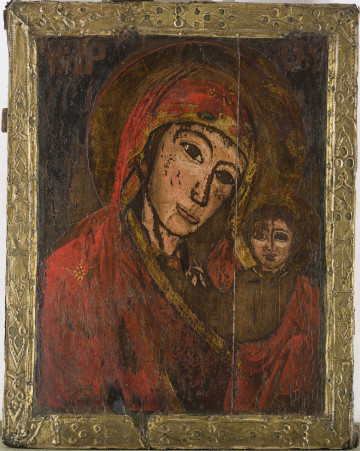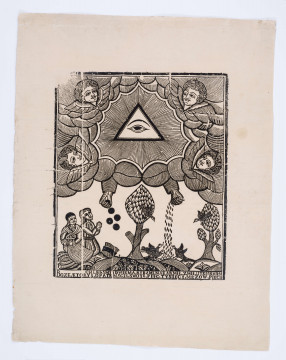
Jesus Christ with the palm of martyrdom
1901 — 1920
National Museum in Lublin
Part of the collection: Folk Art of the Lublin Region (17th–1st half of the 20th c.)
Images of Jesus related to the events preceding the Crucifixion (see E/9393/ML) are sporadic in folk painting. The "Ecce Homo" theme, referring to Pilate's words "Behold the man", in Christian art depicts the Scourged Christ, wearing a crown of thorns and often with his hands bound. It is often modelled on the painting from the sanctuary at the monastery of the Bernardine Fathers in Alwernia in the Lesser Poland province.
The first mention of the miraculous image of the Merciful Christ dates back to 1453. It was then in Constantinople, in the imperial chapel of Constantine XII. After the fall of the Empire, Sultan Mehmed II the Conqueror took it over and placed it in the treasury. The painting, painted on canvas and pasted on an oak board, changed its place of storage several times before it was brought to the monastery in 1686. It was then given to the Bernardine Fathers by Father Jan Franciszek Michalajski, a parish priest from nearby Babice. Adorned with a votive silver cloth in 1700, from the very beginning it was a much visited pilgrimage site, famous for numerous graces and miracles. The Divine Mercy Shrine was visited not only by local residents and pilgrims from Lesser Poland, Silesia and Bohemia, but also by Polish kings (John III Sobieski, Stanislaw August Poniatowski), Cracow cardinals, and Archbishop Karol Wojtyla.
This iconographic motif also had supporters in Polish religious art. The best painting is considered the one painted in Lviv in 1879 by Adam Chmielowski, Saint Brother Albert. Christ on this canvas is depicted against the background of ancient architecture, in a half-form, covered in a scarlet robe, with a crown of thorns on his head, a reed in his hand and a tangled rope around his neck. The light coming from behind the pillar creates a nimbus around his head, and his face, streaked with blood, expresses suffering like in the painting by an unknown folk artist, which was given to a family of sitars in Biłgoraj as a wedding present.
Author / creator
Dimensions
cały obiekt: height: 54 cm, width: 69 cm
Object type
picture
Technique
oil technique
Material
canvas, oil-based paint
Creation time / dating
Creation / finding place
Owner
The National Museum in Lublin
Identification number
Location / status

1901 — 1920
National Museum in Lublin

1801 — 1900
National Museum in Lublin

1901 — 1921
National Museum in Lublin
DISCOVER this TOPIC
National Museum in Lublin
DISCOVER this PATH
Educational path